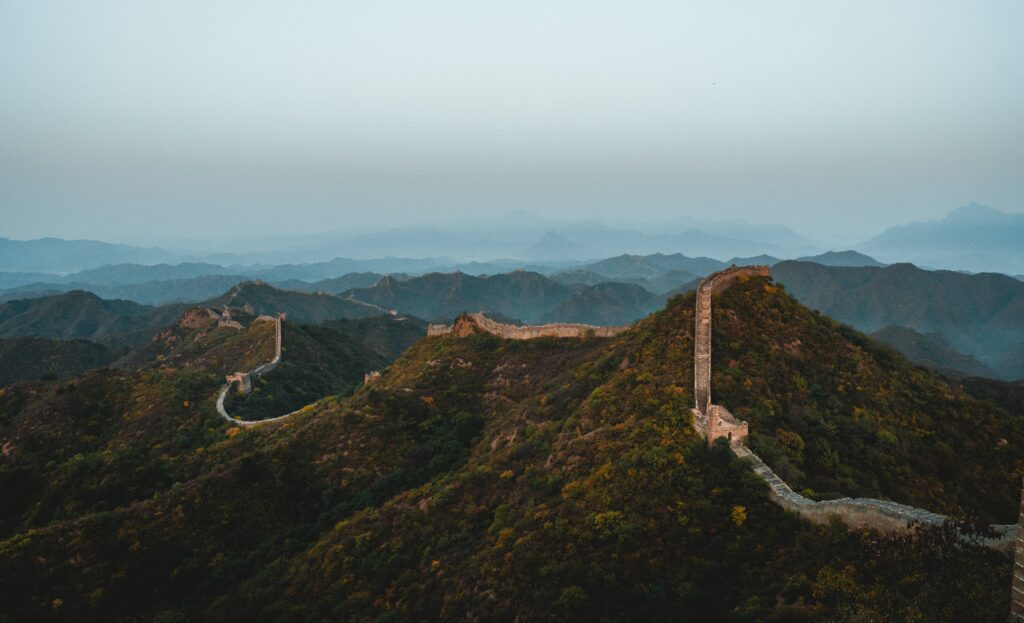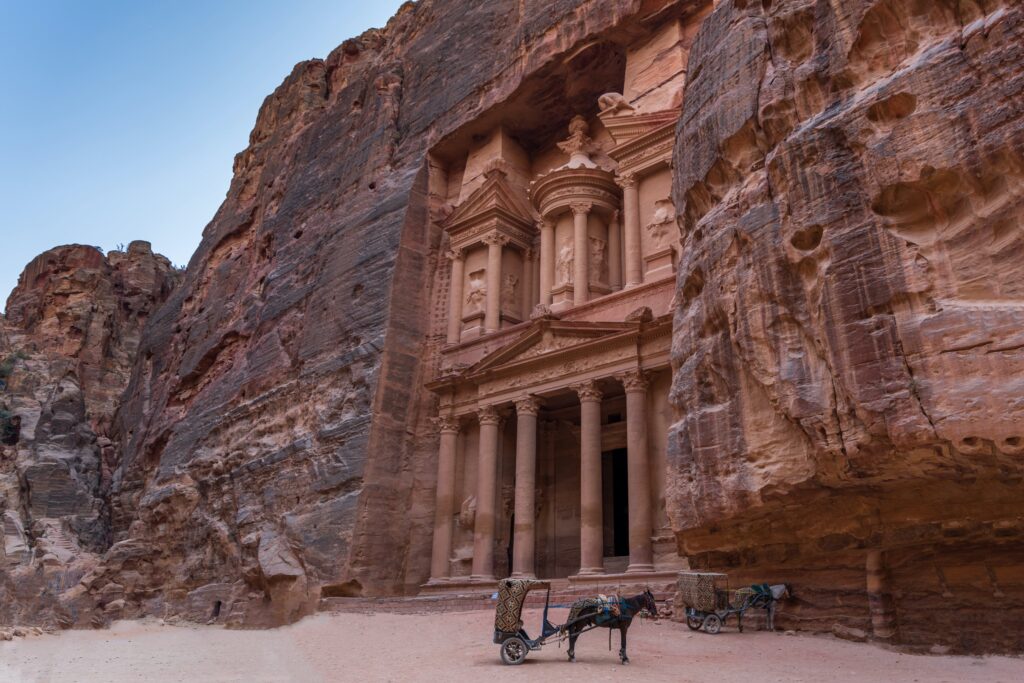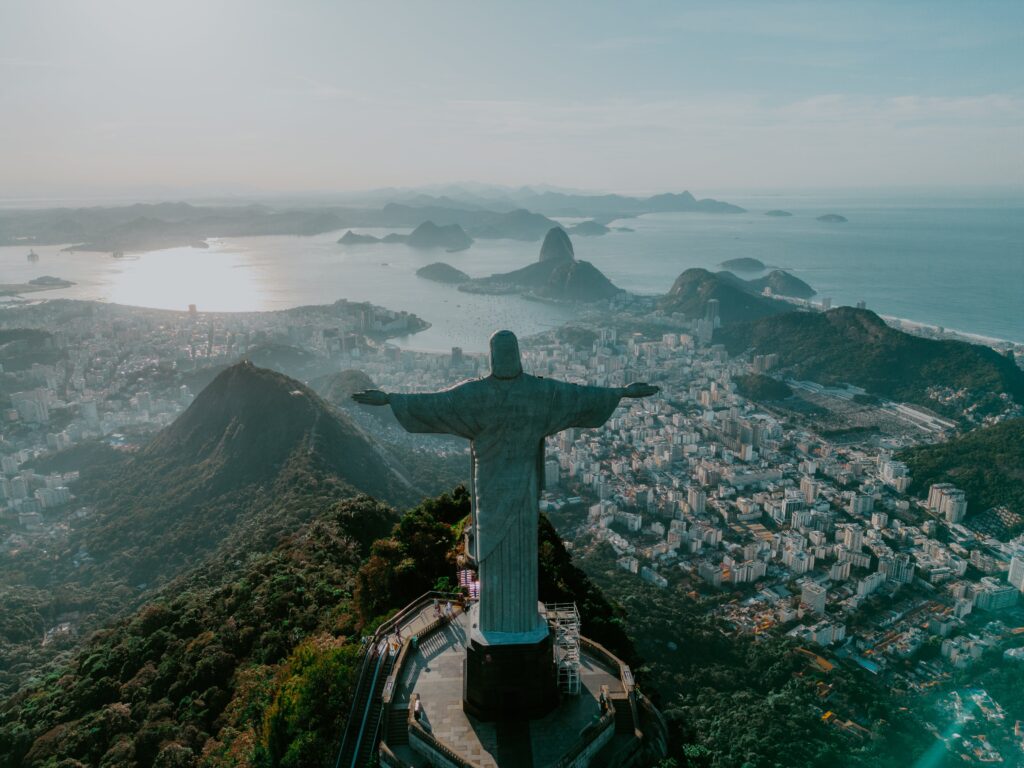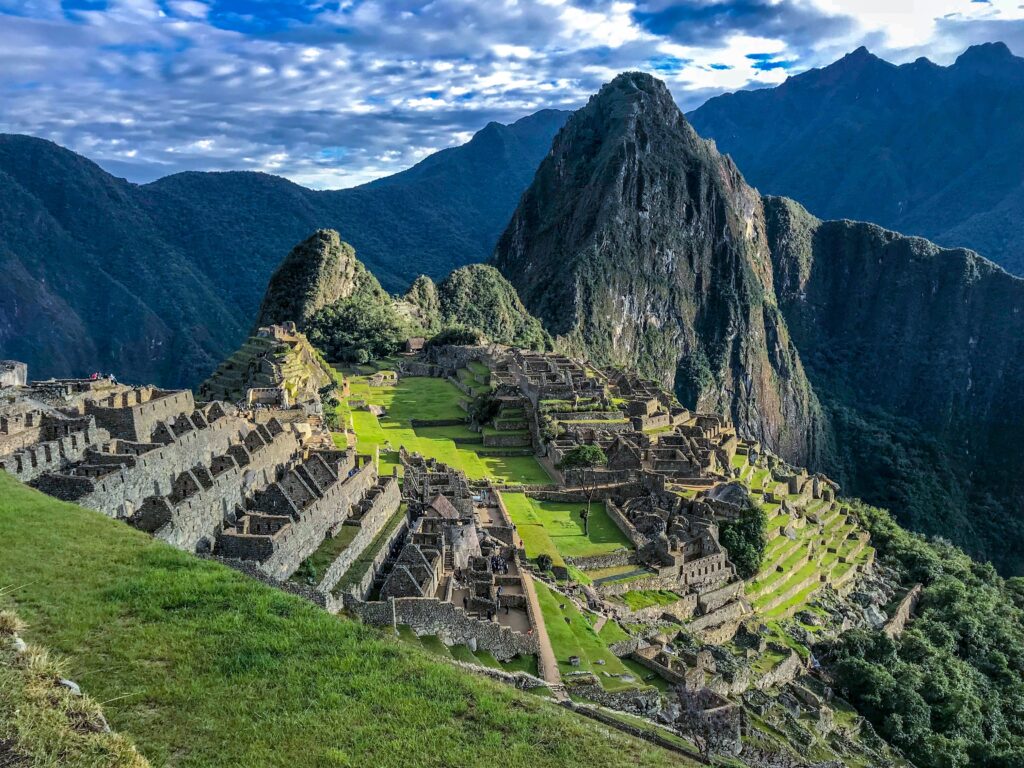1. The Great Wall of China:
Location: Various provinces, China
Stretching across the northern borders of China, the Great Wall stands as an awe-inspiring testament to ancient military engineering and defensive architecture. Built over centuries by various dynasties, this UNESCO World Heritage Site is not just a wall; it’s a complex network of walls, watchtowers, and fortifications.
Key Facts:
- Length and Construction: The Great Wall spans over 21,000 kilometers (13,000 miles) and was constructed over several dynasties, including the Ming, Qin, and Han. It was built to protect against invasions and raids by nomadic tribes.
- Architectural Ingenuity: The wall is not a singular structure but a series of walls, built with a variety of materials, including earth, wood, bricks, and stone. Watchtowers along the wall served as strategic vantage points, allowing defenders to spot approaching threats.
Why It’s Popular:
- Cultural Symbol: The Great Wall is a symbol of China’s rich history and determination to protect its borders. It embodies the strength and resilience of the Chinese people throughout different dynasties.
- Scenic Beauty: Beyond its historical significance, the Great Wall winds through diverse landscapes, offering stunning views of mountains, valleys, and countryside. Sections like Mutianyu and Jinshanling provide a picturesque backdrop for exploration.

As you traverse the Great Wall of China, you’ll step into the pages of history, experiencing the strategic brilliance of ancient Chinese dynasties. The wall not only served as a formidable defense but also stands as a testament to human perseverance and architectural achievement.
Best Time to Visit:
Spring (April to June) and autumn (September to October) offer pleasant weather, making it an ideal time to explore the Great Wall. Summer can be hot, and winter can be cold, so plan your visit according to your temperature preference.
2. petra, jordan:
Location: Ma’an Governorate, Jordan
Nestled within rose-red cliffs, Petra is a UNESCO World Heritage Site and a striking testament to the ancient Nabataean civilization. Carved into the vibrant rocks of southern Jordan, this archaeological wonder unveils a city of exceptional beauty and historical significance.
Key Facts:
- Rock-Cut Architecture: Petra is renowned for its intricate rock-cut architecture, with structures like Al-Khazneh (The Treasury) and Al-Deir (The Monastery) carved directly into the rose-red cliffs. The precision and artistry of these structures reflect the advanced engineering skills of the Nabataeans.
- Ancient Trade Hub: Flourishing as a key trade hub in the ancient world, Petra’s strategic location allowed it to control major trade routes. The city’s prosperity is evident in its well-preserved tombs, temples, and elaborate water conduit system.
- Al-Khazneh: The iconic Al-Khazneh, with its intricate facade, is Petra’s most famous monument. Believed to be a mausoleum, it captivates visitors as they enter the city through the narrow, winding Siq.
Why It’s Popular:
- Historical Enigma: Petra’s history is shrouded in mystery, with its decline and abandonment remaining largely unknown. Exploring this ancient city allows visitors to unravel the enigmatic past of the Nabataean people.
- Cinematic Fame: Petra gained global fame as the backdrop for Indiana Jones and the Last Crusade. The iconic scene featuring Al-Khazneh’s facade is etched in cinematic history and adds to the allure of this archaeological wonder.
Best Time to Visit: The optimal time to visit Petra is during the cooler months, from late autumn to early spring. Avoid the peak of summer when temperatures can be intense. Consider exploring the site early in the morning or late in the afternoon for more pleasant conditions.

Petra’s rose-red beauty and historical intrigue make it a must-visit destination. As you traverse the narrow Siq and witness the grandeur of Al-Khazneh, you’ll be transported to a bygone era, marveling at the architectural and cultural richness of this ancient wonder.
3. christ the redeemer, brazil:
Location: Rio de Janeiro, Brazil
Perched atop the Corcovado mountain, overlooking Rio de Janeiro, Christ the Redeemer stands as an iconic symbol of Brazil and a testament to religious devotion and architectural brilliance. This colossal statue of Jesus Christ is one of the New Seven Wonders of the World.
Key Facts:
- Art Deco Masterpiece: Christ the Redeemer was designed by Brazilian engineer Heitor da Silva Costa and sculpted by French artist Paul Landowski. Its Art Deco style, incorporating reinforced concrete and soapstone, showcases a harmonious blend of engineering and artistic expression.
- Statue Dimensions: The statue reaches a height of 30 meters (98 feet) and has a wingspan of 28 meters (92 feet). Its outstretched arms embrace the city below, symbolizing peace and protection.
Best Time to Visit: For the best views of Rio de Janeiro and the statue, plan your visit on a clear day. The mornings typically offer clearer skies, providing optimal conditions for panoramic photographs. Consider visiting during the off-peak hours to avoid large crowds.

Why It’s Popular:
- Panoramic Views: The panoramic views of Rio de Janeiro from the summit of Corcovado are unparalleled. Visitors are treated to breathtaking vistas of the city, Sugarloaf Mountain, and the expansive coastline.
- Symbol of Faith: Christ the Redeemer holds deep religious significance for Brazilians and serves as a symbol of Christianity and divine protection. Pilgrims and tourists alike are drawn to its spiritual aura.
Christ the Redeemer’s imposing presence atop Corcovado Mountain offers not only spectacular views but also a sense of spiritual serenity. As you ascend to the summit, you’ll be captivated by the blend of natural beauty and human creativity that defines this iconic wonder.
4. machu picchu, peru:
Location: Cusco Region, Peru
Nestled high in the Andes Mountains, Machu Picchu is a breathtaking Inca citadel that continues to captivate the world with its mystical beauty and archaeological significance. This UNESCO World Heritage Site is often referred to as the “Lost City of the Incas.”
Key Facts:
- Inca Engineering Marvel: Machu Picchu showcases the ingenuity of Inca engineering, with its precisely cut stone blocks and terraced agricultural fields. The site’s location, at 2,430 meters (7,970 feet) above sea level, adds to its mystique.
- Purpose and Discovery: Believed to be a royal estate or sacred religious site, Machu Picchu was abandoned by the Inca Empire during the Spanish Conquest and remained hidden for centuries. Hiram Bingham’s rediscovery in 1911 brought international attention to this archaeological gem.
- Inti Watana and Sun Temple: Machu Picchu features significant structures like Inti Watana, a ritual stone associated with astronomy, and the Sun Temple, a semi-circular construction dedicated to the Inca sun god.
Best Time to Visit: The dry season, from May to October, is the ideal time to visit Machu Picchu. During these months, the weather is generally clear, and you’ll have a better chance of experiencing the site without rain. Consider visiting in the morning to witness the mist lifting over the mountain peaks.

Why It’s Popular:
- Scenic Beauty: Surrounded by lush green mountains, Machu Picchu’s scenic beauty is unparalleled. The site’s terraced fields and stone structures blend seamlessly with the natural landscape.
- Cultural Significance: Machu Picchu offers a glimpse into the sophisticated Inca civilization. Its strategic location, advanced agricultural practices, and intricate stonework reflect the depth of Inca knowledge and culture.
Machu Picchu’s enigmatic aura, coupled with its stunning mountainous backdrop, makes it a destination that transcends time. As you explore the ancient ruins, you’ll be transported to a world where the Inca Empire thrived, leaving behind a legacy that continues to inspire wonder and admiration.
5. chicken itza, mexico
Location: Yucatán, Mexico
Chichen Itza, a UNESCO World Heritage Site, is a magnificent archaeological complex that served as a major center of the ancient Maya civilization. Located on the Yucatán Peninsula, this site reveals the architectural and astronomical prowess of the Maya people.
Key Facts:
- El Castillo: El Castillo, the iconic pyramid at Chichen Itza, is a testament to Maya cosmology. During the spring and fall equinoxes, the sunlight creates a shadow that resembles a serpent descending the pyramid, symbolizing the feathered serpent god Kukulkan.
- Ball Court and Observatory: Chichen Itza features a large ball court, where the Maya played the ancient Mesoamerican ballgame. The site also includes an observatory known as El Caracol, highlighting the Maya’s advanced understanding of astronomy.
Best Time to Visit: To witness the phenomenon of the serpent shadow on El Castillo, plan your visit around the spring or fall equinoxes (late March or late September). The dry season, from November to April, offers pleasant weather for exploration.

Why It’s Popular:
- Architectural Splendor: Chichen Itza’s structures, including El Castillo and the Temple of the Warriors, showcase the Maya’s architectural sophistication. The intricate carvings and detailed reliefs add to the site’s aesthetic appeal.
- Cultural Significance: As a major Maya city, Chichen Itza played a crucial role in Mesoamerican culture and trade. The site’s structures provide insights into the religious, social, and economic aspects of the ancient civilization.
Chichen Itza stands as a testament to the intellectual and artistic achievements of the Maya civilization. As you explore the site’s temples, ball courts, and observatories, you’ll gain a deeper appreciation for the rich cultural legacy left behind by one of Mesoamerica’s great civilizations.
6. the colosseum, italy:
Location: Rome, Italy
The Colosseum, also known as the Flavian Amphitheatre, is an iconic symbol of ancient Rome’s grandeur and engineering prowess. Located in the heart of Rome, this colossal amphitheater has witnessed gladiatorial contests, mock sea battles, and dramatic performances, leaving an indelible mark on history.
Key Facts:
- Architectural Innovation: The Colosseum, completed in 80 AD under Emperor Titus, boasts innovative engineering, including a complex system of tunnels and cages beneath the arena floor. This allowed for the spectacular staging of events involving animals and performers.
- Capacity and Design: With a seating capacity of up to 80,000 spectators, the Colosseum was a marvel of ancient stadium design. The elliptical shape provided optimal viewing angles, and a complex system of awnings offered shade to the audience.
Best Time to Visit: Visit the Colosseum in the early morning or late afternoon to avoid the peak midday crowds. Spring (April to June) and fall (September to October) offer mild temperatures, making it an ideal time for exploration.

Why It’s Popular:
- Historical Significance: The Colosseum stands as a symbol of ancient Rome’s cultural and political prominence. It was the epicenter of public entertainment, showcasing the grandeur and might of the Roman Empire.
- Architectural Legacy: The architectural brilliance of the Colosseum has influenced stadium design for centuries. Its enduring legacy is evident in modern sports arenas and entertainment venues.
As you stand within the walls of the Colosseum, envision the roaring crowds and epic spectacles that unfolded in this ancient arena. The Colosseum’s enduring presence speaks to the resilience and innovation of Roman civilization.
7. taj mahal, india:
Location: Agra, India
The Taj Mahal, a sublime masterpiece of Mughal architecture, stands as an enduring symbol of love. Commissioned by Emperor Shah Jahan in memory of his beloved wife Mumtaz Mahal, this ivory-white marble mausoleum is located on the banks of the Yamuna River in Agra.
Key Facts:
- Architectural Elegance: Designed by architect Ustad Ahmad Lahori, the Taj Mahal is a harmonious blend of Persian, Islamic, and Indian architectural styles. Its symmetrical layout, intricate marble inlay work, and majestic dome make it a pinnacle of aesthetic refinement.
- Mumtaz Mahal’s Tomb: The central focus of the Taj Mahal is the tomb of Mumtaz Mahal, adorned with delicate floral patterns and Quranic inscriptions. The white marble reflects different hues at different times of the day, creating a captivating play of light.
Best Time to Visit: The best time to visit the Taj Mahal is during the cooler months from October to March. The early morning hours provide a serene atmosphere, and the changing sunlight enhances the beauty of the marble. Avoid visiting on Fridays, as the monument is closed for public viewing.

Why It’s Popular:
- Symbol of Eternal Love: The Taj Mahal is a poignant symbol of eternal love, with Shah Jahan’s deep affection for Mumtaz Mahal immortalized in its construction. It has become a universal symbol of love and beauty.
- Cultural and Religious Significance: The Taj Mahal is recognized as a UNESCO World Heritage Site and holds cultural and religious significance for the people of India. Its architectural brilliance and historical narrative draw millions of visitors from around the world.
As you stand before the Taj Mahal, marvel at the exquisite craftsmanship and the enduring love story that gave birth to this architectural gem. The Taj Mahal’s timeless beauty transcends cultures, inviting visitors to witness the power of love immortalized in marble.
These wonders, each unique in its cultural significance and architectural splendor, invite travelers on a global journey through time. Whether exploring the ancient wonders of Egypt and Rome or admiring the natural beauty of Petra and Machu Picchu, each destination offers a glimpse into the rich tapestry of human history and achievement.
